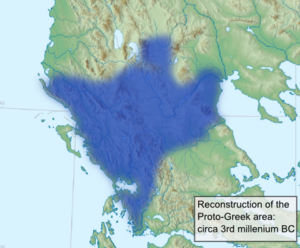
Back প্রত্ন-গ্রিক ভাষা Bengali/Bangla Protogrec Catalan Urgriechisch German Πρωτοελληνική γλώσσα Greek Proto-Greek language English زبان نیایونانی Persian Alkukreikka Finnish Proto-grec French Lingua protogrega Galician פרוטו-יוונית HE
| Proto-helénico | ||
|---|---|---|
| Hablado en | N. de Grecia | |
| Hablantes | Lengua muerta | |
| Familia | Proto-helénico | |
| Estatus oficial | ||
| Oficial en | Ningún país. | |
| Códigos | ||
| ISO 639-2 | itc-pro | |
 Reconstrucción "área proto-griega" del milenio 3.er a. C. por Vladimir I. Georgiev.[1]
| ||
El protogriego, también denominado proto-helénico (Πρωτοελληνική, προϊστορική κοινή o προδιαλεκτική en Griego moderno), era la protolengua indoeuropea que se asume que fue el último antepasado común de todas las variedades del griego, incluyendo el griego micénico, los dialectos del griego antiguo (dórico, eólico, jónico-ático, macedonio antiguo y arcadio-chipriota) y, por consiguiente, del koiné, bizantino y moderno.
Los hablantes de proto-griego habrían entrado en lo que actualmente es Grecia entre el 2200 y el 1900 a. C.,[2][3][4] dándose posteriormente una diversificación dialectal entre un grupo meridional y un grupo septentrional hacia el 1700 a. C.[5][6][7][8][9] La unidad del protogriego habría acabado cuando migrantes helénicos, hablantes del predecesor de la lengua micénica, entraron en la península griega en algún momento de la Edad de Bronce.[10]
- ↑ Vladimir Georgiev Georgiev, 1981
- ↑ Drews, Robert (1994). The Coming of the Greeks: Indo-European Conquests in the Aegean and the Near East. Princeton University Press. p. 14. ISBN 0691029512.
- ↑ West, M. L. (23 de octubre de 1997). The East Face of Helicon : West Asiatic Elements in Greek Poetry and Myth: West Asiatic Elements in Greek Poetry and Myth (en inglés). Clarendon Press. p. 1. ISBN 978-0-19-159104-4. «"the arrival of the Proto-Greek -speakers took place at various sites in central and southern Greece at the beginning and end of the Early Helladic III period.»
- ↑ Asko Parpola; Christian Carpelan (2005). «The cultural counterparts to Proto-Indo-European, Proto-Uralic and Proto-Aryan : matching the dispersal and contact patterns in the linguistic and archaeological record». En Edwin Bryant; Laurie L. Patton, eds. The Indo-Aryan Controversy: Evidence and Inference in Indian History. Psychology Press. pp. 107-141. ISBN 978-0-7007-1463-6.
- ↑ Hall, Jonathan M. (1997). Ethnic Identity in Greek Antiquity (en inglés). Cambridge University Press. p. 160. ISBN 978-0-521-78999-8.
- ↑ Woodard, Roger D. (2008). The Ancient Languages of Europe (en inglés). Cambridge University Press. p. 52. ISBN 978-1-139-46932-6.
- ↑ Horrocks, Geoffrey (2010). Greek: A History of the Language and its Speakers (en inglés). John Wiley & Sons. pp. 19-20. ISBN 978-1-4443-1892-0.
- ↑ Parker, Holt N. (2008). «The Linguistic Case for the Aiolian Migration Reconsidered». Hesperia: The Journal of the American School of Classical Studies at Athens (American School of Classical Studies at Athens) 77 (3): 443-444. ISSN 0018-098X. JSTOR 40205757. S2CID 161497388. doi:10.2972/hesp.77.3.431.
- ↑ A comprehensive overview is in J. T. Hooker's Mycenaean Greece (Hooker, 1976, Chapter 2: "Before the Mycenaean Age", pp. 11–33 and passim); for a different hypothesis excluding massive migrations and favoring an autochthonous scenario, see Colin Renfrew's "Problems in the General Correlation of Archaeological and Linguistic Strata in Prehistoric Greece: The Model of Autochthonous Origin" (Renfrew, 1973, pp. 263–276, especially p. 267) in Bronze Age Migrations by R. A. Crossland and A. Birchall, eds. (1973).
- ↑ A comprehensive overview in J.T. Hooker's Mycenaean Greece (Hooker, 1976); for a different hypothesis excluding massive migrations and favoring an autochthonous scenario, see Colin Renfrew's "Problems in the General Correlation of Archaeological and Linguistic Strata in Prehistoric Greece: The Model of Autochthonous Origin" (Renfrew, 1973) in Bronze Age Migrations by R.A. Crossland and A. Birchall, eds. (1973).